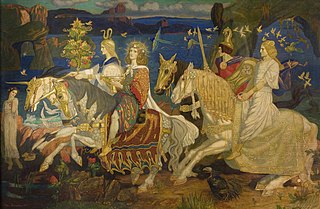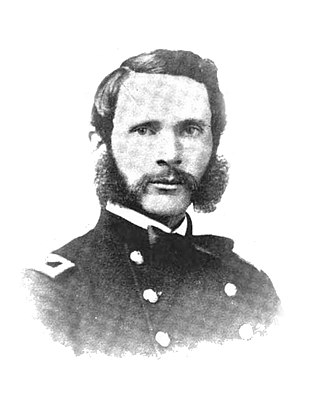
Irish mythology is the body of myths indigenous to the island of Ireland. It was originally passed down orally in the prehistoric era. In the early medieval era, some myths were transcribed by Christian monks, who heavily altered and Christianised the myths. Irish mythology is the best-preserved branch of Celtic mythology.

Lugh or Lug is a figure in Irish mythology. A member of the Tuatha Dé Danann, a group of supernatural beings, Lugh is portrayed as a warrior, a king, a master craftsman and a saviour. He is associated with skill and mastery in multiple disciplines, including the arts. Lugh also has associations with oaths, truth and the law, and therefore with rightful kingship. Lugh is linked with the harvest festival of Lughnasadh, which bears his name. His most common epithets are Lámfada and Samildánach. This has sometimes been anglicised as "Lew of the Long Hand".

The Morrígan or Mórrígan or Danu, also known as Morrígu, is a figure from Irish mythology. The name is Mór-ríoghan in modern Irish before the spelling reform, and it has been translated as "great queen" or "phantom queen".
The Dagda is considered the great god of Irish mythology. He is the chief god of the Tuatha Dé Danann, with the Dagda portrayed as a father-figure, king, and druid. He is associated with fertility, agriculture, manliness and strength, as well as magic, druidry and wisdom. He can control life and death, the weather and crops, as well as time and the seasons.
The Battle of Badon, also known as the Battle of Mons Badonicus, was purportedly fought between Britons and Anglo-Saxons in Post-Roman Britain during the late 5th or early 6th century. It was credited as a major victory for the Britons, stopping the westward encroachment of the Anglo-Saxon kingdoms for a period.
In Irish mythology, Balor or Balar was a leader of the Fomorians, a group of malevolent supernatural beings, and considered the most formidable. He is often described as a giant with a large eye that wreaks destruction when opened. Balor takes part in the Battle of Mag Tuired, and is primarily known from the tale in which he is killed by his grandson Lugh of the Tuatha Dé Danann. He has been interpreted as a personification of the scorching sun, and has also been likened to figures from other mythologies, such as the Welsh Ysbaddaden and the Greek Cyclops.

In Gallo-Roman religion, Loucetios was a Gallic god known from the Rhine-Moselle region, where he was identified with the Roman Mars. Scholars have interpreted his name to mean ‘lightning’. Mars Loucetius was worshipped alongside the goddess Nemetona.
Olaf Guthfrithson or Anlaf Guthfrithson was a Hiberno-Scandinavian (Irish-Viking) leader who ruled Dublin and Viking Northumbria in the 10th century. He was the son of Gofraid ua Ímair and great-grandson of Ímar, making him one of the Uí Ímair. Olaf succeeded his father as King of Dublin in 934 and succeeded in establishing dominance over the Vikings of Limerick when he captured their king, Amlaíb Cenncairech, in 937. That same year he allied with Constantine II of Scotland in an attempt to reclaim the Kingdom of Northumbria which his father had ruled briefly in 927. The forces of Olaf and Constantine were defeated by the English led by Æthelstan at the Battle of Brunanburh in 937.
140 is the natural number following 139 and preceding 141.

The Fenian Cycle, Fianna Cycle or Finn Cycle is a body of early Irish literature focusing on the exploits of the mythical hero Finn or Fionn mac Cumhaill and his warrior band the Fianna. Sometimes called the Ossianic Cycle after its narrator Oisín, it is one of the four groupings of Irish mythology along with the Mythological Cycle, the Ulster Cycle, and the Kings' Cycles. Timewise, the Fenian cycle is the third, between the Ulster and Kings' cycles. The cycle also contains stories about other famous Fianna members, including Diarmuid, Caílte, Oisín's son Oscar, and Fionn's rival Goll mac Morna.

Sir William Penn was an English admiral and politician who sat in the House of Commons from 1660 to 1670. He was the father of William Penn, founder of the colonial Province of Pennsylvania, which is now the US Commonwealth of Pennsylvania.
In Irish mythology, Uaithne is Dagda's harp, or rather the Dagda's harper, according to a number of modern translators.

The Ulster Cycle, formerly known as the Red Branch Cycle, is a body of medieval Irish heroic legends and sagas of the Ulaid. It is set far in the past, in what is now eastern Ulster and northern Leinster, particularly counties Armagh, Down and Louth. It focuses on the mythical Ulster king Conchobar mac Nessa and his court at Emain Macha, the hero Cú Chulainn, and their conflict with the Connachta and queen Medb. The longest and most important tale is the epic Táin Bó Cúailnge. The Ulster Cycle is one of the four 'cycles' of Irish mythology and legend, along with the Mythological Cycle, the Fianna Cycle and the Kings' Cycle.

The Mythological Cycle is a conventional grouping within Irish mythology. It consists of tales and poems about the god-like Tuatha Dé Danann, who are based on Ireland's pagan deities, and other mythical races such as the Fomorians and Fir Bolg. It is one of the four main story 'cycles' of early Irish myth and legend, along with the Ulster Cycle, the Fianna Cycle and the Cycles of the Kings. The name "Mythological Cycle" seems to have gained currency with Arbois de Jubainville c. 1881–1883. James MacKillop says the term is now "somewhat awkward", and John T. Koch notes it is "potentially misleading, in that the narratives in question represent only a small part of extant Irish mythology". He prefers T Ó Cathasaigh's name, Cycle of the Gods. Important works in the cycle are the Lebor Gabála Érenn, the Cath Maige Tuired, the Aided Chlainne Lir and Tochmarc Étaíne.
Cairbre Lifechair, son of Cormac mac Airt, was, according to medieval Irish legend and historical tradition, a High King of Ireland. He came to the throne after the death of Eochaid Gonnat. During his time Bresal Belach was king of Leinster, and refused to pay the bórama or cow-tribute to the High King, but Cairbre defeated him in the Battle of Dubchomar [source?], and from then on exacted the bórama without a battle.
Horseleap is a village on the border of County Offaly and County Westmeath in Ireland. It is on the R446 road, formerly the main Dublin to Galway road. Horseleap has a church, primary school, garden centre, pub and petrol station. The village dates back to the 12th century and is steeped in Uí Néill, Geoghegan history.

Patrick Henry O'Rorke or O'Rourke was an Irish-American immigrant who became a colonel in the Union Army during the American Civil War and was killed at the Battle of Gettysburg.
Ragnall ua Ímair or Rægnald was a Viking leader who ruled Northumbria and the Isle of Man in the early 10th century. He was a grandson of Ímar and a member of the Uí Ímair. Ragnall was most probably among those Vikings expelled from Dublin in 902, whereafter he may have ruled territory in southern Scotland or the Isle of Man. In 917, he and his kinsman Sitric Cáech sailed separate fleets to Ireland where they won several battles against local kings. Sitric successfully recaptured Dublin and established himself as king, while Ragnall returned to England. He fought against Constantín mac Áeda, King of Scotland, in the Battle of Corbridge in 918, and although the battle was not decisive it did allow Ragnall to establish himself as king at York.
Tommaltach mac Indrechtaig was a King of Dal nAraide in Ulaid (Ulster) and possible King of all Ulaid. He was the son of Indrechtach mac Lethlobair, a previous King of Dal nAraide. He ruled from 776 to 790 and as King of all Ulaid from 789 to 790. He belonged to the main ruling dynasty of the Dal nAraide known as the Uí Chóelbad based in Mag Line, east of Antrim town in modern county Antrim.
Feardomhnach of Tuam, died 777.